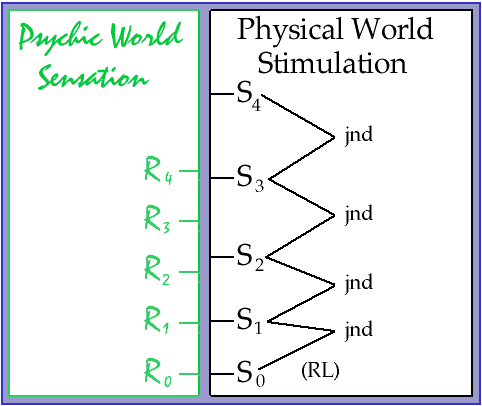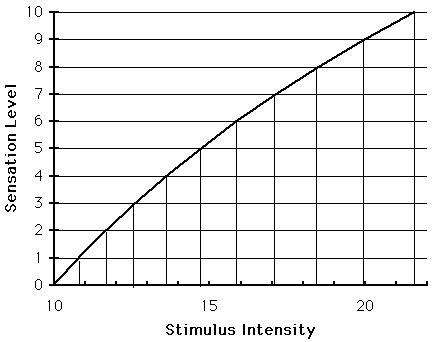October 22, 1850
Gustav Fechner's Law "S = k Log R"
- Philosophers had argued for centuries that sensation ("conscious experience") doesn't take up space and since it doesn't you can't measure it.
- Physical quantities can be be subdivided and not be qualitatively changed.
- 1 qt of water = 1 cup of water + 1 cup of water + 1 cup of water + 1 cup of water
- But how do you do that with psychological phenomenon. How can you break down a red experience and talk about adding together 4 pinks (each is red-experience but less not much of it) to produce red (obviously a lot of red experience)?
- Fechner woke up one day and realized there was a way to measure the magnitude of sensations.
- He built on the work of others who had been measuring stimulus thresholds (what is the weakest stimulus you can detect? what is the smallest difference in intensity between two stimuli that you can detecct?).
- Given the information on stimulus thresholds, Fechner realized there was an equation that would allow you to describe changes in the magnitude of psychological events ("How much sweeter is it now") in terms of changes in the stimulus ("I'll dissolve another teaspoon of sugar in the coffee.")
- Sensation increases as the logrithm of stimulus intensity or "S = k log R".
- So what you say? Well this is as revolutionary as E = mc2.
- Einstein's equation says that energy and matter are interchangable. They are the same thing and you can convert a given amount of matter into a given amount of energy.
- Fechner's law says mind (conscious experience) and matter (stimulus intensity) are the same thing as well.
- This was a BIG DEAL.
- If you can measure sensation then you can do science on the mind, on conscious experience. WOW!.
But first we need some basic concepts.
Psychophysical Problems Introduced
- Detection Problem
- What is the weakest stimulus you can detect
- That stimulus is known as the Absolute Threshold (RL)
- Discrimination Problem
- What is the smallest difference between two stimuli you can detect?
- That difference is known as the just noticeable difference (jnd)
- The stimulus just-noticeably-different from another stimulus is the Difference Limen (DL).
- Scaling Problem
- As stimulus intensity changes how does psychological intensity change?
- Stimulus change=The amount of electromagnetic radiant energy in the room; psychological intensity change=How bright the room looks.
- Stimulus change=dissolve more sugar in the water; psychological intensity change=the water tastes sweeter.
Fechner's idea was to markoff equally different sensations in terms of the stimuli that produce them. In the picture below:
The World of Stimulation--the Physical World
- S0 is the absolute threshold (RL) stimulus.
- This stimulus is the weakest stimulus you can detect.
- What is the least sucrose that can be dissolved in 1 liter of water so you can taste it.
- How this misleads: There isn't a "weakest" even though it sounds reasonable. On any presentation a stimulus may be detected or not. Weaker stimuli have a lower probability of detection. Detection is "all-or-none" but there is no stimulus which is always detected and then weakened a tad and never detected.
- S1 is the stimulus just-noticeably-different from the RL stimulus.
- If the difference were any smaller, then you would say there is no difference between the stimuli.
- How this misleads: Again, there's no such stimulus. On any presentation a pair of stimuli either feel different or they don't. We can measure the proportion of time two stimuli feel different but again there is no difference that is never detected and then made a tad larger and always felt as different.
- The remaining stimuli each is just-noticeably-more-intense than the one before.

The Psychic World--The World of Sensation
- R0 is the least conscious experience of a stimulus you can have. Any less experience is no experience! If the water were any less sweet you'd say it wasn't sweet at all.
- R1 is the experience of sweet that is the least possible increase in sweetness. Any smaller increase in the experience is no different than the experience R0.
- Likewise R2 and R1 differ by the least possible difference in experience. The two liquids would be "equally sweet" if the experienced sweetness of R1 were any less.
There is NO evidence of a connection between the two worlds beyond the equation.
- There are no lines connecting stimuli with sensations. Its important that you realize there is no mechanism telling how energy is converted into sensation.
- We can investigate and describe, in considerable detail, the mechanisms by which radiant energy impinges on the retinal receptors and cause changes in neural activity.
- We can NOT specify how changes in neural activity are related to changes in sensation.
Weber's Law: A jnd is a constant proportion of stimulation (jnd/STD=k)
- In the 1830s a German physiologist discovered that for mid-range stimuli, two stimuli will be just-noticeably different when you change one stimulus by k% of the other stimulus. K is known as the Weber Constant.
- "jnd" is a confustion measure. Two stimuli a jnd apart will be confused 50% of the time (in a commonly-used measurement method).
- For small lifted weights, k is about .04. A 4% change will be just noticeable.
- A 100 and 104 gms are a jnd apart; so are 1000 and 1040 gms.
- As the stimulus you are measuring the jnd from gets larger the amount of stimulation needed for a jnd gets larger in terms of the measured units of the stimulus. 4 grams at 100; 8 gm at 200; 20 gm at 500; etc.
- Here is a table k for several sensory modalities.
Fechner's Law Redux
- S = k log R
- Equal sensed differences are produced by equal stimulus ratios.
- The table illustrates the "log" relationship. Each stimulus is 8% larger than the one before.
- The figure shows that equal size steps in sensation are produced by stimuli that increase in a constant proportion (aka a geometic ratio).
- Fechner's law argues that all jnds are the same perceived size.
- Fechner says, the 4 gm difference between 100 gm and 104 gm feels the same difference as the jnd of 40 gm between 1000 and 1040.
- Fechner is wrong--While those two differences are equally confusable, they don't feel the same. The 40 gm difference feels larger.
©2002 by Burrton Woodruff. All rights reserved. Modified Friday, June 7, 2002


